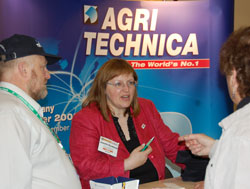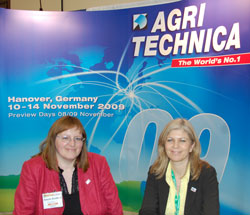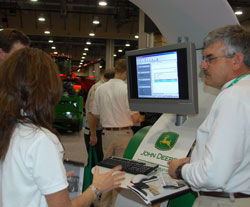 Ask any grower who is succeeding with the various tools of precision agriculture, and you’ll hear about the importance of the local dealer’s field technician–such as John Deere’s AMS Technician program.
Ask any grower who is succeeding with the various tools of precision agriculture, and you’ll hear about the importance of the local dealer’s field technician–such as John Deere’s AMS Technician program.
For anyone interested in this growing job field, check out Oklahoma State University’s Institute of Technology, which offers a two-year Associate in Applied Science degree in Precision Agriculture Technology.
Graduates from the new program will be prepared for a higher level of agriculture, in which most new jobs require skills in GIS, GPS, and remote sensing in addition to the familiar disciplines of agronomy, plant science, and agri-business.
OSU Institute of Technology students will be learning to use GPS and GIS technologies to provide detailed information to farmers on their crop’s health status, irrigation and fertilizer need, plus warn of attacks by insects or weeds.
OSU Institute of Technology’s program is designed to meet the needs of two types of students: those who want to earn an associate’s degree in agriculture with high employment potential; or those who want to complete their first two years of an agriculture degree, then transfer to OSU’s Stillwater campus to earn their bachelor’s degree.
To learn more about this program, check out the information guide.

 Representatives from the world’s largest agricultural machinery exhibition were talking with farmers at the Commodity Classic in Grapevine, Texas this week about planning a visit to Hanover, Germany in November.
Representatives from the world’s largest agricultural machinery exhibition were talking with farmers at the Commodity Classic in Grapevine, Texas this week about planning a visit to Hanover, Germany in November. Annette Reichhold (left) and Dr. Malene Conlong, with conference organizer DLG, tell me that Agritechnica is considered the global agricultural “gathering point” and is often the chosen venue for manufacturers to unveil new innovations.
Annette Reichhold (left) and Dr. Malene Conlong, with conference organizer DLG, tell me that Agritechnica is considered the global agricultural “gathering point” and is often the chosen venue for manufacturers to unveil new innovations. A record number of growers are attending the biggest ever trade show at the 2009 Commodity Classic this week in Grapevine, Texas. No economic crisis here!
A record number of growers are attending the biggest ever trade show at the 2009 Commodity Classic this week in Grapevine, Texas. No economic crisis here!
 The cost of fertilizer has more growers looking for increased efficiency. And growers I talk to who use soil sampling, fertility maps and the variable-rate technology of precision farming are very pleased with the results.
The cost of fertilizer has more growers looking for increased efficiency. And growers I talk to who use soil sampling, fertility maps and the variable-rate technology of precision farming are very pleased with the results. The 90-ft. planter has now been eclipsed, by a whopping 30%. 120 feet of precision planting packed into the new John Deere/Bauer Built DB120. It was introduced at the recent National Farm Machinery Show, where Precision.AgWired.com offered an
The 90-ft. planter has now been eclipsed, by a whopping 30%. 120 feet of precision planting packed into the new John Deere/Bauer Built DB120. It was introduced at the recent National Farm Machinery Show, where Precision.AgWired.com offered an  The message that technology of precision farming allows greater efficiency was heard loud and clear from presenters at the ninth annual Nebraska Agricultural Technologies Association conference, recently held in Grand Island.
The message that technology of precision farming allows greater efficiency was heard loud and clear from presenters at the ninth annual Nebraska Agricultural Technologies Association conference, recently held in Grand Island. Calling all growers who haven’t experienced the input saving possibilities of GPS-based precision farming.
Calling all growers who haven’t experienced the input saving possibilities of GPS-based precision farming. 